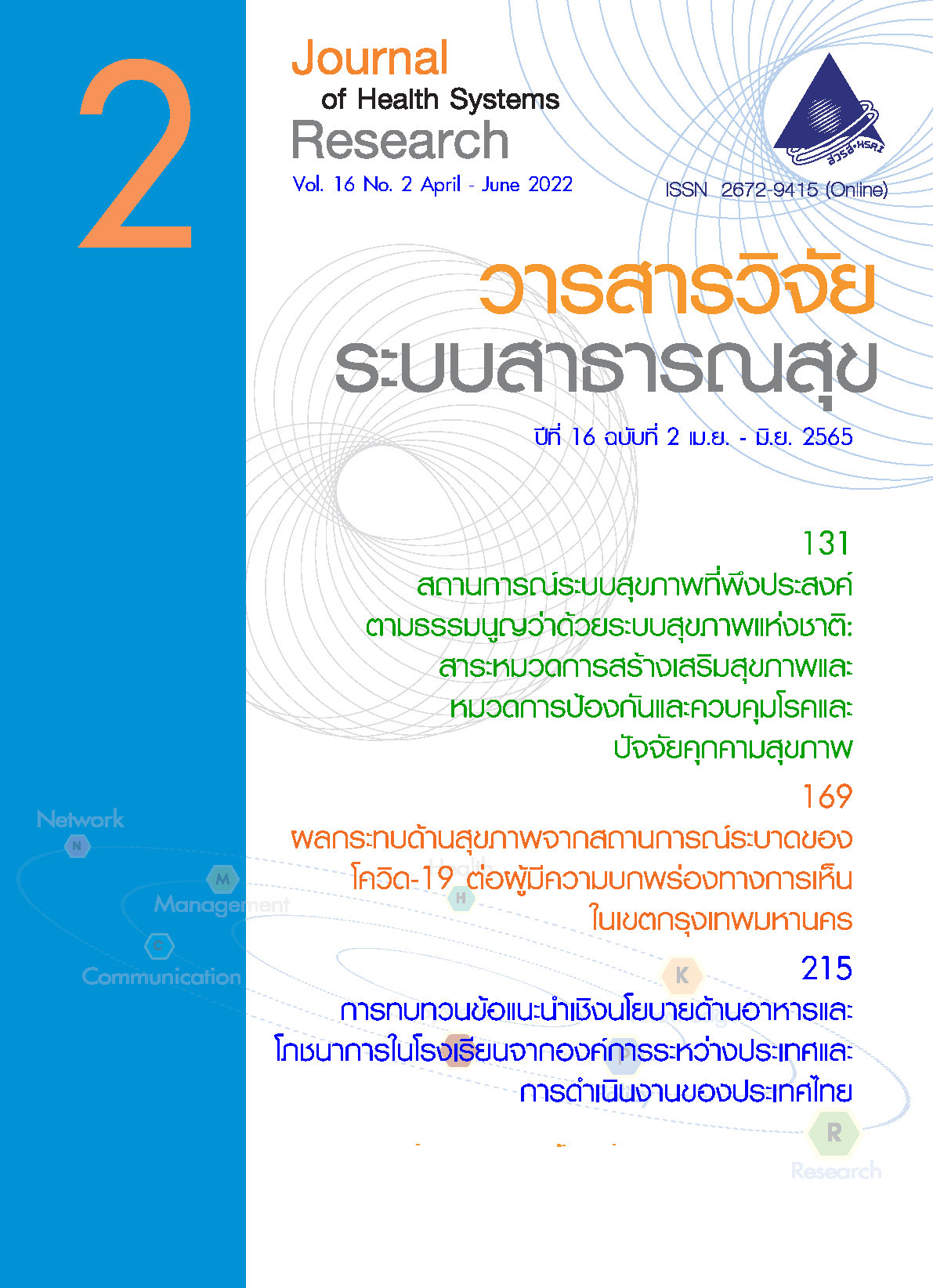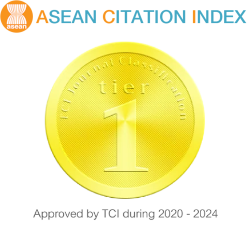The Health Impact of the COVID-19 Pandemic on Visually Disabled Persons in Bangkok
Keywords:
COVID-19, visually disabled person, vaccine, health impactAbstract
The coronavirus disease 2019 (COVID-19) pandemic has impacted on health and well-being of the population, particularly vulnerable groups. The purposes of this study were to explore health impact of COVID-19 regarding public health measure on people with visual impairment in Bangkok, to analyze factors affecting the impact, and to make recommendations to support visually impaired people in the situation of COVID-19 outbreak. A cross-sectional survey was conducted. Questionnaires were used to collected data between June and July, 2021. A combination of purposive and snowball technique was applied to select 140 visually impaired people to the study. Data were analyzed using descriptive (percentage, mean, standard deviation) and inferential statistics (ANOVA, t-test, chi-square). Findings revealed that the outbreak and public health measures affected visually impaired people’s daily lives, occupation, and economic and emotional stress. Moreover, they faced difficulty in using public services due to social change in the new normal era. However, the government’s measures in response to the impact of COVID-19 on visually impaired group were not inclusive in design. For instance, there was a lack of system to support the constraints of the visually impaired, and health communication was inappropriate in terms of format and channel. The government should show empathy and implement comprehensive policies for visually impaired people with empathy, such as improve access for public services, improve access to health care services, as well as increase access to COVID-19 vaccine.
References
Department of Disease Control. Coronaviras disease (COVID-19) dashboard. Ministry of Public Health [Internet]. [cited 2021 Sep 2]. Available from: https://ddc.moph.go.th/covid19-dashboard. (in Thai)
Office of the Council or State. Extension of Duration of the Declaration of an Emergency Situation in all areas of the Kingdom of Thailand (13th Extension). Office of the Prime Minister [Internet]. 2021 [cited 2021 Aug 1]. Available from: http://www.ratchakitcha.soc.go.th/DATA/PDF/2564/E/168/T_0031.PDF. (in Thai)
Office of the Council or State. Regulation Issued under Section 9 of the Emergency Decree on Public Administration in Emergency Situations B.E. 2548 (2005). Office of the Prime Minister [Internet]. 2021 [cited 2021 Aug 10]. Available from: http://www.ratchakitcha.soc.go.th/DATA/PDF/2564/E/140/T_0001.PDF. (in Thai)
United Nations Thailand. Socio-economic impact assessment of COVID-19 in Thailand [internet] .Oct 2020 [cited 2021 May 15]. Available from: https://thailand.un.org/sites/default/files/2021-02/UN%20Thailand%20Socio-Economic%20Impact%20Assessment%20of%20Covid-19%20in%20Thailand-EN-low%20res.pdf.
Tarat S. Senses and sensory experience in the world of the blind. J. Mekong Soc. 2018;14(2):141-64.
Sirindhorn National Medical Rehabilitation Institute. Manual on management of visual impairment persons [Internet]. Department of Medical Services. Chapter 3, How to navigate visual impairment persons. [cited 2021 Jul 3]. Available from: http://www.snmri.go.th/snmri-e-library. (in Thai)
Senjam SS. Impact of COVID-19 pandemic on people living with visual disability. Indian J Ophthalmol. 2020;68(7):1367-70.
Gombas J, Csakvari J. Experiences of individuals with blindness or visual impairment during the COVID-19 pandemic lockdown in Hungary. Br J Vis Impair [Internet]. 2021;40(2):378-88. [cited 2021 Aug 1]. Available from: https://journals.sagepub.com/. doi: 10.1177/0264619621990695.
Kwegyir Tsiboe A. Describing the experiences of older persons with visual impairments during COVID-19 in rural Ghana. J Adult Prot. 2020;22(6):371-83.
World Health Organization. Disability considerations during the COVID-19 outbreak [internet]. Geneva: World Health Organization. 2020. [cited 2021 Jun 1]. Available from: https://apps.who.int/iris/handle/10665/332015.
Department of Empowerment of Persons with Disabilities. National plan for developing the quality of life of disable persons 5th edition B.E. 2560-2564 (2017-2021) [Internet]. Ministry of Social Development and Human Security. 2017 [cited 2021 Jul 2]. Available from: http://web1.dep.go.th/sites/default/files/files/law.pdf. (in Thai)
Taimkao S, Tiamkao S. Tele-neurology during the COVID-19 pandemic as a solution for bridging the healthcare gap. J Med Assoc Thai. 2021;104:94-6.
Department of Medical Services. Thailand’s new normal solutions for building resilience for emerging infectious diseases (EID) in healthcare facilities (White paper) [internet]. 2020 [cited 2021 May 20]. Available from: http://www.adpc.net/NNM/Mebook/EID_EN_31Mar_2206pm.pdf.
Wilkinson RG, Marmot M, World Health Organization. Regional Office for Europe, WHO Centre for Urban Health (Europe) & International Centre for Health and Society (1998). Social determinants of health: the solid facts/ edited by Wilkinson RG, Marmot M [internet]. Copenhagen: WHO Regional Office for Europe; 1998. [cited June 10]. Available from: https://apps.who.int/iris/handle/10665/108082.
Department of Empowerment of Persons with Disabilities. Empowerment of Persons With Disabilities Act, B.E. 2550 (2007) (Sep 18, 2007) [Internet]. Ministry of Social Development and Human Security. 2007. [cited 2021 May 1]. Available form: http://law.m-society.go.th/law2016/uploads/lawfile/593114244ee36.pdf.
Department of Empowerment of Persons with Disabilities. Registry database of visual diability persons in Thailand [Internet]. Ministry of Social Development and Human Security. 1994-2005 [cited 2021 May 1]. Available form: https://data.go.th/dataset/item_b5966a54-0b48-4128-b180-a22d2baed159.
Office of National Statistical. The 2017 disability survey [internet]. 2020. Available from: http://www.nso.go.th/sites/2014en/Survey/social/SocialSecurity/Disabilitysurvey/2017/Full_Report.pdf. (in Thai)
Peters MA, Besley TAC. Social exclusion/inclusion: Foucault’s analytics of exclusion, the political ecology of social inclusion and the legitimation of inclusive education. Open Review of Educational Research. 2014;1(1):99-115.
Sørensen K, Pelikan JM, Röthlin F, Ganahl K, Slonska Z, Doyle G, et al. Health literacy in Europe: comparative results of the European health literacy survey (HLS-EU). Eur J Public Health. 2015;25(6):1053-8.
Thaker J. The persistence of vaccine hesitancy: COVID-19 vaccination intention in New Zealand. J Health Commun. 2021;26(2):104-11.
Kerr JR, Schneider CR, Recchia G, Dryhurst S, Sahlin U, Dufouil C, et al. Correlates of intended COVID-19 vaccine acceptance across time and countries: results from a series of cross-sectional surveys. BMJ open. 2021;11(8):e048025.
Posetti J, Bontcheva K. Disinfodemic: Deciphering Covid-19 disinformation. Policy brief 1 [Internet]. Paris: UNESCO; 2021. [cited 2021 Aug 2]. Available from: https://en.unesco.org/sites/default/files/disinfodemic_deciphering_covid19_disin-formation.pdf.
Downloads
Published
How to Cite
Issue
Section
License
Copyright (c) 2025 Journal of Health Systems Research

This work is licensed under a Creative Commons Attribution-NonCommercial-NoDerivatives 4.0 International License.
Journal of Health Systems Research is licensed under a Creative Commons Attribution-NonCommercial-NoDerivatives 4.0 International (CC BY-NC-ND 4.0) license, unless otherwise stated.




